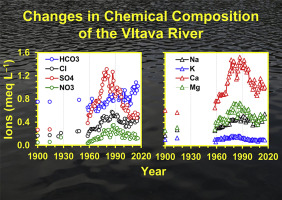当前位置:
X-MOL 学术
›
Water Res.
›
论文详情
Our official English website, www.x-mol.net, welcomes your feedback! (Note: you will need to create a separate account there.)
Trends in riverine element fluxes: A chronicle of regional socio-economic changes
Water Research ( IF 12.8 ) Pub Date : 2017-08-30 , DOI: 10.1016/j.watres.2017.08.067 Jiří Kopáček , Josef Hejzlar , Petr Porcal , Maximilian Posch
Water Research ( IF 12.8 ) Pub Date : 2017-08-30 , DOI: 10.1016/j.watres.2017.08.067 Jiří Kopáček , Josef Hejzlar , Petr Porcal , Maximilian Posch

|
We show how concentrations of water solutes in the Vltava River (Czech Republic) and their riverine outputs from the catchment were modified by socio-economic changes, land use, and hydrology between 1960 and 2015. In the early 1960s, HCO3 and Ca were the dominant ions. During 1960–1989 (a period of planned economy with an over-use of synthetic fertilizers, excessive draining of agricultural land and little environmental protection), the riverine concentrations of strong acid anions (SAAs: SO4, NO3, and Cl) increased 2–4-fold and their leaching was accompanied for by a 1.4–1.8-fold increase in concentrations of Ca, Mg, K, and Na. SAAs mostly originated from diffuse agricultural sources (synthetic fertilizers and mineralization of organic matter in freshly drained and deeply tilled agricultural land) and their annual average concentrations (as well as those of Ca, Mg, and K) were positively correlated with discharge. During 1990–2015 (a period of a re-established market economy, reduced fertilization, ceased drainage, partial conversion of arable land to pastures, and increasing environmental protection), concentrations of SO4 and NO3 significantly decreased due to reduced agricultural production and atmospheric pollution, and their positive correlations with discharge disappeared. In contrast, Na and Cl concentrations increased due to more intensive road de-icing, and their concentrations became negatively correlated with discharge. Trends in phosphorus concentrations reflected changes in its input by both diffuse (fertilizers) and point (wastewater) sources and were discharge independent.
中文翻译:

河流元素通量趋势:区域社会经济变化的编年史
我们展示了伏尔塔瓦河河(捷克共和国)中的水溶质浓度及其流域的河水产出如何在1960年至2015年之间受到社会经济变化,土地利用和水文学的影响。在1960年代初期,HCO 3和Ca优势离子。在1960年至1989年(计划经济时期,过度使用合成肥料,过度流失农田和几乎没有环境保护)期间,河流中的强酸阴离子浓度(SAAs:SO 4,NO 3),和Cl)增加2-4倍,其浸出过程中Ca,Mg,K和Na的浓度增加1.4-1.8倍。SAA主要来自散布的农业资源(合成肥料和新鲜排水和深耕农田中有机物的矿化),并且它们的年平均浓度(以及Ca,Mg和K的年平均浓度)与排放呈正相关。在1990年至2015年期间(市场经济恢复,减少施肥,停止排水,将耕地部分转化为牧场以及增强环境保护的时期),SO 4和NO 3的浓度由于农业生产减少和大气污染而显着下降,并且它们与排放量的正相关关系消失了。相反,Na和Cl的浓度由于更强的道路除冰而增加,并且它们的浓度与排放负相关。磷浓度的趋势反映了其扩散源(肥料)和点源(废水)的输入变化,并且与排放无关。
更新日期:2017-08-31
中文翻译:

河流元素通量趋势:区域社会经济变化的编年史
我们展示了伏尔塔瓦河河(捷克共和国)中的水溶质浓度及其流域的河水产出如何在1960年至2015年之间受到社会经济变化,土地利用和水文学的影响。在1960年代初期,HCO 3和Ca优势离子。在1960年至1989年(计划经济时期,过度使用合成肥料,过度流失农田和几乎没有环境保护)期间,河流中的强酸阴离子浓度(SAAs:SO 4,NO 3),和Cl)增加2-4倍,其浸出过程中Ca,Mg,K和Na的浓度增加1.4-1.8倍。SAA主要来自散布的农业资源(合成肥料和新鲜排水和深耕农田中有机物的矿化),并且它们的年平均浓度(以及Ca,Mg和K的年平均浓度)与排放呈正相关。在1990年至2015年期间(市场经济恢复,减少施肥,停止排水,将耕地部分转化为牧场以及增强环境保护的时期),SO 4和NO 3的浓度由于农业生产减少和大气污染而显着下降,并且它们与排放量的正相关关系消失了。相反,Na和Cl的浓度由于更强的道路除冰而增加,并且它们的浓度与排放负相关。磷浓度的趋势反映了其扩散源(肥料)和点源(废水)的输入变化,并且与排放无关。


























 京公网安备 11010802027423号
京公网安备 11010802027423号